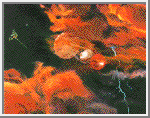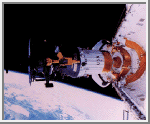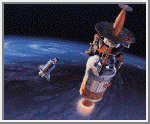











|
Courtesy of the Jet Propulsion Laboratory
The Galileo spacecraft was designed to study Jupiter's atmosphere, satellites, and surrounding magnetosphere for two years. The spacecraft was named in honor of Galileo Galilei, the Italian Renaissance scientist who discovered Jupiter's major moons in 1610. The Galileo spacecraft was carried into space by the shuttle Atlantis on October 18, 1989. Once released from the cargo bay, a two-stage Inertial Upper Stage (IUS) booster fired to accelerate the spacecraft out of Earth orbit toward the planet Venus. From there, Galileo will spend more than five years traveling to Jupiter, where it will become the first spacecraft to make direct measurements from an instrumented probe within Jupiter's atmosphere. It will also become the first spacecraft to conduct long-term observations of Jupiter, its magnetosphere, and satellites from orbit around Jupiter. But Galileo has already earned a "first" -- the first spacecraft to encounter an asteroid and to photograph an asteroid's moon.
The Galileo orbiter, weighing 2-1/2 tons, was designed and developed by the Jet Propulsion Laboratory, which manages the mission for NASA. The 340-kilogram (746-pound) atmospheric probe was developed by NASA's Ames Research Center. Hughes Aircraft Company acted as the prime contractor. The German government is a partner in the mission through its provisions of the spacecraft propulsion subsystem and two science experiments. The spacecraft carries 10 scientific instruments, six of which are located on the probe. The spacecraft's radio link to Earth and the probe-to-orbiter radio link are also used to conduct scientific investigations.
Like Voyager and other interplanetary spacecraft, Galileo used gravity assists from Venus and Earth to gain enough momentum to travel to Jupiter. Galileo spent the first three years of its journey making flybys of Venus and Earth before it was ready to swing outward toward Jupiter. These gravity-assist encounters provided Galileo with the opportunity to conduct brief scientific observations of Venus, at closest approach on February 10, 1990, and of Earth and the Moon, with closest approaches on December 8, 1990 and December 8, 1992. During this phase of the mission, the spacecraft made two planned visits to the asteroid belt beyond the orbit of Mars and provided the first opportunities for close observation of these bodies. In October 1991, Galileo flew by the asteroid Gaspra, obtaining the world's first close-up asteroid images. In August 1993, it flew by a second asteroid, Ida, and discovered the first confirmed asteroid moon, named Dactyl. In July 1994 Galileo was the only observer to obtain images of the far side of Jupiter when more than 20 fragments of Comet Shoemaker-Levy 9 plunged into Jupiter's nightside atmosphere over a six-day interval.
Galileo will arrive at Jupiter, on December 7, 1995, and perform several important tasks to place itself in the correct orbit around Jupiter. It will then relay 75 minutes of data from an atmospheric probe as it descends into Jupiter's atmosphere. The spacecraft will be making its closest flyby of Io at the same time, just 1,000 kilometers (620 miles) away, and perform scientific investigations of Io's volcanic moon. Once the probe's signal is lost and the probe is crushed from the tremendous pressure of Jupiter's atmosphere, the larger part of the spacecraft, the orbiter, will begin its two-year tour of the Jovian environment. It will make 11 orbits around the planet and many of its 16 moons, taking advantage of 10 close satellite encounters to conduct science investigations.
| Views of Galileo |
|---|
 Galileo
Galileo
In this artist's rendering the Galileo probe, with its heat
shield below and a parachute above, enters the turbulent upper
atmosphere of Jupiter. Galileo released its probe in September 1995,
about 150 days before it was scheduled to reach Jupiter.
The orbiter's trajectory will be
corrected to send it into Jupiter orbit. The probe was scheduled to enter
the upper atmosphere on December 7, 1995, at about 48 kilometers
(30 miles) per second. Data from its
six instruments were to be relayed to Earth via the orbiter during
the probe's expected 75 minutes of operation before temperature
and pressure destroy it.
(Courtesy NASA/JPL)
 Galileo Deployment
Galileo Deployment
The Galileo spacecraft and its Inertial Upper Stage booster rocket were
deployed from the space shuttle Atlantis October 18, 1989. Shortly
thereafter, the booster rocket fired and separated, sending Galileo on
its six-year journey to the planet Jupiter. Upon its arrival at Jupiter
in December 1995, Galileo will release a probe into the atmosphere so
that scientists can survey the composition of the planet's clouds. The
orbiter will relay probe information and will survey and photograph
Jupiter and some of its major satellites.
(Courtesy NASA/JPL)
 The Journey Begins
The Journey Begins
This artist's concept depicts the Inertial Upper Stage booster rocket
firing shortly after its deployment from the shuttle
Atlantis. Galileo's complex trajectory to Jupiter flung it by Venus
once and then back to Earth for two fly-bys. Each pass added kinetic
energy to the spacecraft, increasing its velocity so that it could
reach Jupiter with a relatively small amount of fuel.
(Courtesy NASA/JPL)
 Hubble Views the Galileo Probe Entry Site
Hubble Views the Galileo Probe Entry Site
This image, taken by the Hubble Space Telescope,
shows the predicted
site at which the Galileo Probe will enter Jupiter's atmosphere on
December 7, 1995. At this latitude, the eastward winds have speeds of
about 250 miles per hour (110 meters per second). The white oval to
the north of the probe site drifts westward at 13 miles per hour (6
meters per second), rolling in the winds which increase sharply toward
the equator.
The four enlarged images of Jupiter's equatorial
region show clouds sweeping across the predicted Galileo probe entry
site, which is at the exact center of each frame (a small white dot has
been inserted at the centered at the predicted entry site).
(Credit: Reta Beebe, New Mexico State University, and NASA)
Copyright © 1997-2000 by Calvin J. Hamilton. All rights reserved. Privacy Statement.